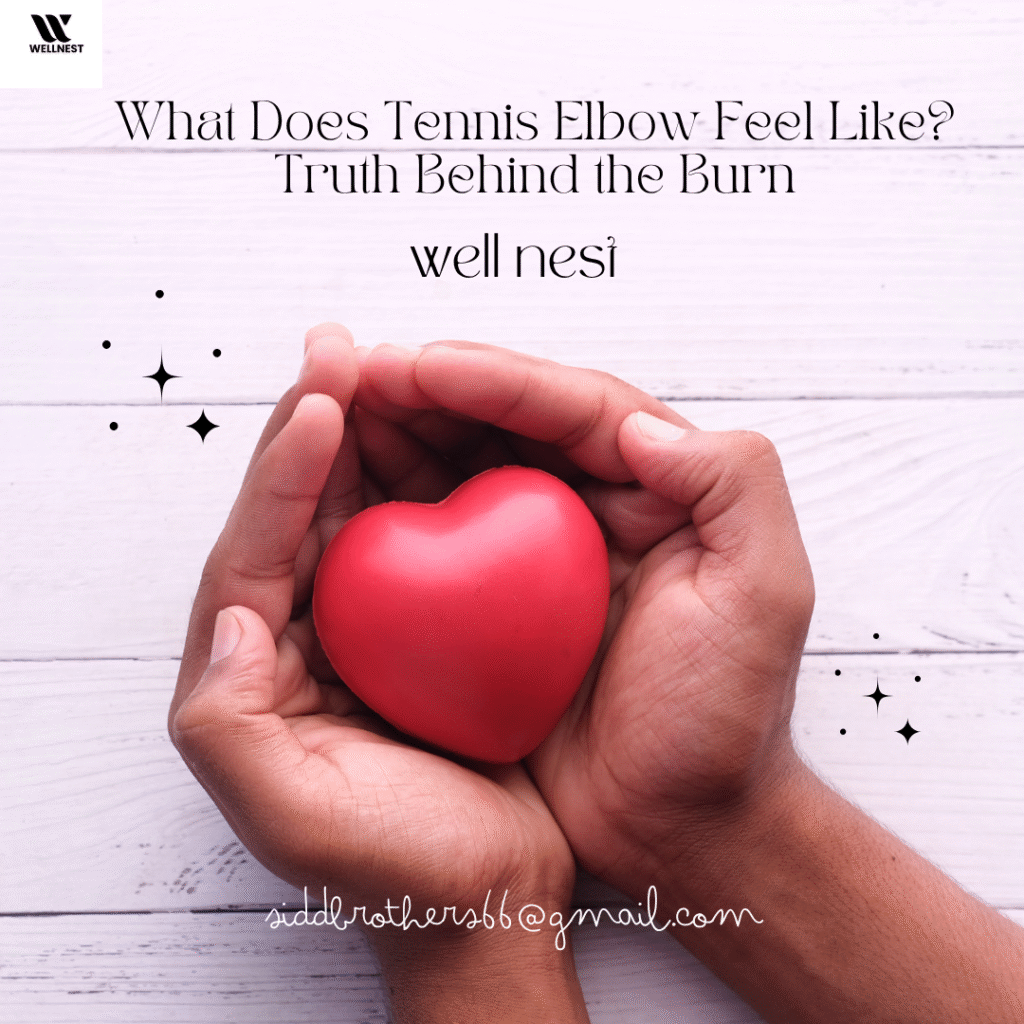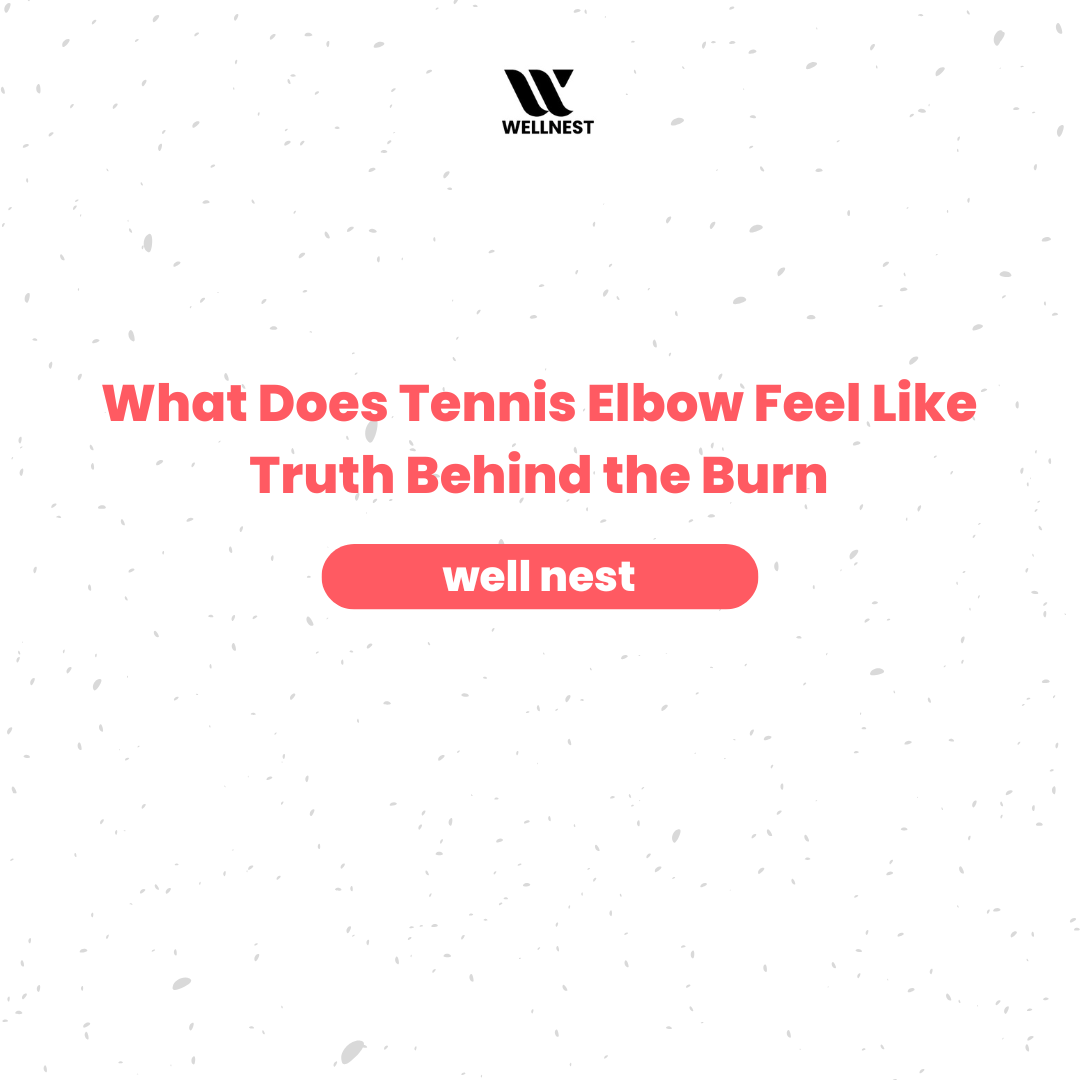Tennis Elbow: What is it? What Are Its Causes, Signs, and Recovery?
Have you ever felt a sharp twinge on the exterior of your knee while turning a doorknob, raising a suitcase, or keeping hold of your coffee mug? That persistent ache is more likely to be high than just weariness—it is likely to be tennis elbow.
This condition is more common than you would expect. And you don’t even have to play tennis to get it despite the name. So, what does tennis elbow feel like, exactly?
This guide will tell you all you need to know about the symptoms, diagnosis, and treatment – in simple terms. It will also explain how long it takes, how to cure it, and what real people on Reddit and other forums say.
Tennis Elbow Treatment: What Actually Works to Relieve the Pain
Most people first wonder: how do you cure tennis elbow?
The Cleveland Clinic claims treatment for tennis elbow typically starts with common conservative, non-surgical methods such as:
1. Rest and Ice.
The elbow should be rested from the activity carried out on a repetitive basis
Ice it 3–4 times a day for 15–20 minutes
2. Wear a Tennis Elbow Brace
A tennis elbow brace , or counterforce strap, takes pressure off the tendon
Especially useful for activities such as typing, lifting, or gripping
Physical Therapy
Strengthening and stretching exercises to help heal the tendon
May include eccentric exercises, wrist flexion/extension, and resistance bands
Injections, if needed
Corticosteroids can provide short-term relief
PRP , or platelet-rich plasma, can be injected to aid long-term healing
Surgery , only for chronic cases
Performed for long-term pain persisting after 6–12 months
Damaged tendon removed while reattaching any remaining healthy tissue
How Long Does Tennis Elbow Last? Understanding Recovery Time
A common question is, “How long does tennis elbow last?”
The short answer is: it depends.
Most people find that tennis elbow gets better within three to six months with rest and self-care. However, more severe or chronic cases may take up to 18 months to fully heal – especially if you don’t stop doing the activity that caused it in the first place.
Pro tip: the sooner you start treatment, the sooner you’ll be back to normal.

Want to know how it feels to have tennis elbow in real life? Read people’s anonymous comments:
in my case, first, it was just a slight discomfort, but after a week, holding even a cup of coffee
was unbearable; then every single time I tried to lift something, my outer elbow ached.“Feels like getting stabbed with a pencil.”
“It’s terrible while squeezing something or twisting a key. It seems to go far down into the joint. “
These are the classic signs: extreme agony, poor grip, and discomfort that persists until it is worn out Best.
Tennis Elbow Exercises: Moves to Help With Strength & Recovery
One of the most important aspects of recovery is the appropriate tennis elbow exercises to help stretch and strengthen the forearm.
Take some suggestions from the doctor: .
1. Finger Stretch with Rubber Band ,
three times a day,
slowly spread out your fingers and put a rubber band around them.
3 sets of 10
2. Ball Squeeze
Use a rubber ball or soft ball to
squeeze and relax.
10 reps, 5-7 times a week
3. Wrist Stretch to stand.
wiggle your arm out straight
Use other hand to pull fingers gently.
Hold 15s, repeat 5x per arm.
4. Towel Twist.
Hold a rolled towel.
Twist as if wringing out water.
3 sets of 10 in both directions.
5. Resistance Band Elbow Curls.
Anchor band under foot.
Curl palm-up toward shoulder.
3 sets of 10 reps.
Always check with your doctor or physical therapist before starting a new routine.

Tennis Elbow Brace: Why and When You Should Use One.
Using a tennis elbow brace is one of the most effective tools during recovery.
A brace helps by:.
Reducing stress on the damaged tendon.
Dispersing force during gripping/lifting.
Allowing healing while staying active.
Use it while doing things like :.
Typing or mousing.
Cooking or cleaning.
Weightlifting.
Play instruments
gardening, for example.
You will probably need a brace during early treatment and flares. Is It Ever Permanent?
Tennis elbow doesn’t have to be permanent.
Many cases go away with appropriate treatment. In fact,
the chances of getting your life back without surgery for tennis elbow are pretty good.
Most patients recover as long as they do the following:
● Rest the elbow
● Brace
● Rehab
● Don’t reinjure
Depending on the type and extent of the damage, only 5–10% of cases actually develop into a chronic issue and require surgery. Want to heal faster? Want to mitigate some of that time off the court?
We’ve got some tips on how to heal tennis elbow fast so you can get back in the game:
1. Get Treatment Quickly:
Don’t let the pain get unmanageable. Go with the RICE formula first. That stands for Rest, Ice, Compression, Elevation the first signs.
Interrupt the Trigger Activity
If it’s typing or lifting or swinging, move less or alter how you go.
Rehab Daily
Consistency in doing exercises is more critical than doing intense sessions.
Take Anti-Inflammatories if Approved
NSAIDS such as ibuprofen can alleviate pain and inflammation; nonetheless, consult the doctor before taking it.
Put on an Counterforce Brace
It works to alleviate the strain on the tendon straightaway. Healing quickly depend on action, not patience.
Elbow Pain When Lifting and Gripping: Can it be Tennis Elbow?
Does your elbow pain when lifting and gripping, or is there something amiss when doing it? This is a customary symptom of tennis elbow.
Pain frequently erupts in the following environments.
Exercising with a dumbbell
Pouring from a jug
Opening the door
Twisting a screwdriver
Picking up groceries
If the pain is located on the outside of your elbow and is aggravated by any wrist or finger movement, it is most likely lateral epicondylitis.
In this case, it is reasonable to discontinue the activity, ice the elbow, and use a brace. In case the length exceeds a week, consult a healthcare provider.
Conclusion: Understand how tennis elbow feels to take action ahead of time Although
tennis elbow starts minor, it can develop into a more complex issue. Now that you have a clear idea of what tennis elbow feels like, you can quickly detect it early and take the necessary steps to prevent it from worsening.
To summarize,
it feels like a sharp, burning
pain on the elbow’s outside that increases with twisting or lifting.
Treat it with ice, bracing, exercises, and restache:
Most cases go away with time and treatment;
Heart surgery is rarely neededatch, I.
Whether you’re an athlete, an office worker, or a weekend warrior, how to catch and treat tennis elbow early will save you from long-term discomfort.
